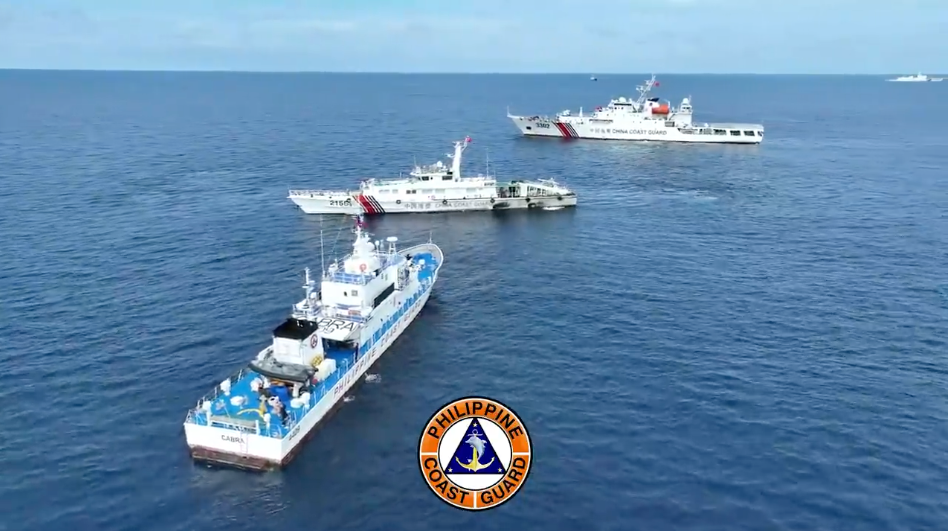South China Sea Tension: China Pressures Philippines On Missile Deployment

Table of Contents
China's Assertions and Claims in the South China Sea
China's actions in the South China Sea are a major driver of the current South China Sea tension. Beijing's expansive claims and assertive military posture directly challenge the sovereignty and security interests of neighboring nations, including the Philippines.
The Nine-Dash Line Controversy
The core of the dispute lies in China's controversial "nine-dash line," a vaguely defined demarcation on maps claiming historical rights to the vast majority of the South China Sea. This claim overlaps significantly with the Exclusive Economic Zones (EEZs) of several Southeast Asian nations, including the Philippines.
- Overlap with Philippine EEZ: The nine-dash line encompasses significant portions of the Philippines' EEZ, rich in fishing grounds and potential hydrocarbon reserves.
- International Law Challenges: The nine-dash line is not recognized under the United Nations Convention on the Law of the Sea (UNCLOS), which establishes clear guidelines for maritime boundaries and resource claims. The Philippines successfully challenged this claim in an international arbitration tribunal in 2016, a ruling China has ignored.
- Historical Evidence Disputes: China's historical claims are contested by other claimant states, who present evidence contradicting Beijing's narrative. The lack of clear historical documentation supporting China's expansive claims fuels ongoing disputes.
China's Military Buildup
China's military buildup in the South China Sea is another key aspect of the escalating South China Sea tension. Beijing has engaged in extensive island-building, deploying advanced military hardware and significantly increasing its naval and air force presence.
- Increased Patrols: Chinese coast guard and naval vessels regularly patrol disputed waters, often harassing and intimidating fishing vessels and other ships from neighboring countries.
- Modernization of Military Infrastructure: Artificial islands constructed by China now boast airstrips, military bases, and sophisticated radar systems, enhancing China's surveillance and projection of power capabilities in the region.
- Impact on Freedom of Navigation: China's assertive actions pose a direct threat to freedom of navigation, a cornerstone of international maritime law and crucial for global trade. The increasing militarization of the area raises concerns about potential conflict.
The Philippines' Response and Security Concerns
Faced with China's assertive actions, the Philippines is actively seeking ways to safeguard its sovereignty and protect its interests in the South China Sea. This has led to increased South China Sea tension and a heightened focus on national defense.
Justification for Missile Deployment
The Philippines' consideration of missile deployments is a direct response to the perceived threat from China. The deployments aim to enhance the country's defensive capabilities and deter further aggression.
- Protection of Fishing Grounds: Protecting Filipino fishermen from harassment and intimidation by Chinese vessels is a central concern.
- Safeguarding Maritime Resources: The Philippines seeks to protect its access to and control of resources within its EEZ.
- Response to China's Assertive Actions: Missile deployment is seen as a necessary measure to counter China's growing military presence and assertive behavior.
Strengthening Alliances
Recognizing the limitations of its own capabilities, the Philippines is actively strengthening its alliances with key partners, most notably the United States, but also Japan and Australia, to bolster its defense capabilities and counterbalance China's influence.
- Joint Military Exercises: Increased joint military exercises with allies enhance interoperability and demonstrate a united front against China's assertiveness.
- Increased Defense Cooperation: The Philippines is engaging in enhanced intelligence sharing and collaborative defense planning with its allies.
- Potential for Arms Sales and Technology Transfer: The increased cooperation is likely to lead to greater access to advanced defense technologies and equipment.
International Implications and Regional Stability
The escalating South China Sea tension has significant implications for regional stability and the global order. The actions of China and the Philippines have ramifications beyond the immediate region.
Impact on Regional Trade and Navigation
The South China Sea is a crucial waterway for global trade, with billions of dollars worth of goods transiting the area annually. Escalating tensions pose a significant risk to this vital trade route.
- Economic Consequences for Regional Countries: Disruptions to trade could have severe economic consequences for countries in the region that depend heavily on maritime commerce.
- Impact on Global Supply Chains: Any major disruption in the South China Sea could have far-reaching repercussions for global supply chains.
- Potential for Maritime Incidents: The increased military presence and heightened tensions raise the risk of accidental or intentional clashes between naval vessels, potentially escalating into wider conflicts.
International Community Response
The international community has expressed serious concern about the escalating South China Sea tension. Many countries have called for de-escalation and adherence to international law.
- Calls for De-escalation: Numerous countries, including the United States and members of the Association of Southeast Asian Nations (ASEAN), have called on all parties to de-escalate tensions and resolve their disputes peacefully.
- Diplomatic Efforts: Various diplomatic initiatives have been undertaken to encourage dialogue and negotiation between China and the Philippines, although progress has been limited.
- Potential for Sanctions or Other Punitive Measures: While unlikely in the near term, the possibility of sanctions or other punitive measures against China remains a potential response if tensions continue to escalate and international norms are disregarded.
Conclusion
The South China Sea tension, especially regarding China's pressure on the Philippines' missile deployment plans, presents a significant threat to regional stability and the rules-based international order. The situation underscores the urgent need for diplomatic solutions, respect for international law, and a steadfast commitment to peaceful conflict resolution. Continued monitoring of the South China Sea tension is vital, as the potential for miscalculation and escalation remains dangerously high. We must advocate for a peaceful resolution to these disputes through open dialogue and adherence to international law to ensure the stability of the region. Understanding the complexities of the South China Sea tension is paramount for informed global citizenship and responsible policymaking. Let's work towards de-escalation and a lasting peaceful resolution to the ongoing South China Sea tension.

Featured Posts
-
 Lekler I Khemilton Perviy Duet Ferrari Diskvalifitsirovanniy Na Odnoy Gonke
May 20, 2025
Lekler I Khemilton Perviy Duet Ferrari Diskvalifitsirovanniy Na Odnoy Gonke
May 20, 2025 -
 Man United And Arsenal Battle For Matheus Cunha Signing
May 20, 2025
Man United And Arsenal Battle For Matheus Cunha Signing
May 20, 2025 -
 D Wave Quantum Inc Qbts Stocks Sharp Decline A Monday Market Analysis
May 20, 2025
D Wave Quantum Inc Qbts Stocks Sharp Decline A Monday Market Analysis
May 20, 2025 -
 Retired Admiral Robert Burke Guilty Verdict In Bribery Case
May 20, 2025
Retired Admiral Robert Burke Guilty Verdict In Bribery Case
May 20, 2025 -
 Affaire Aramburu Point Sur L Enquete Et La Traque Des Suspects Neo Nazis
May 20, 2025
Affaire Aramburu Point Sur L Enquete Et La Traque Des Suspects Neo Nazis
May 20, 2025
